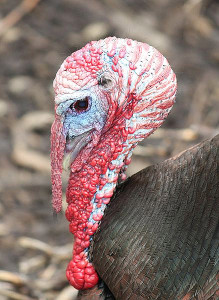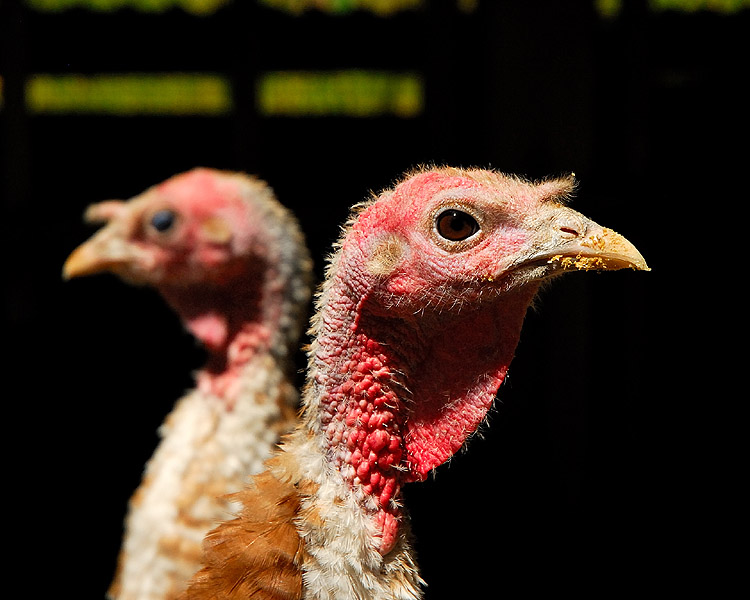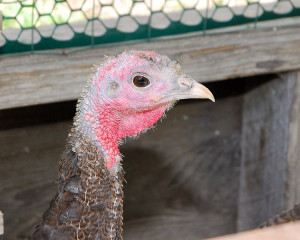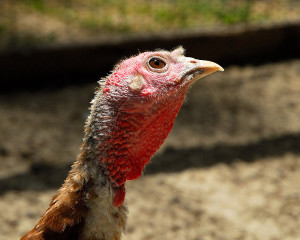After yesterday’s disappointing post, as promised, we have a turkey update! Our turkeys are now 11 weeks old, and have lost almost all of their adorable ‘baby turkey’ features. They’re now more in the realm of gangly teenagers.
It’s still a little early to be certain as to our ratio of juvenile males (Jakes) to juvenile females (Jennys). For some pure breeds there may be genetic differences in coloration to hint as to the sex of each bird by this stage, but as our birds are crossed between Bourbon Red and Standard Bronze, or Bourbon Red and Royal Palm, we have no idea what to expect for coloration at this stage. We’ve not had turkeys here at the farm before, but we have been watching for developmental cues as to who is who. Thus far, we expect we have three Jakes, and one Jenny (Tom and Hen are terms are reserved for mature birds that are close to a year in age). This in part is based on the rate of feather loss on their heads, behavior differences, and some sexually dimorphic differences such as snood size, and tarsal width.
As I’ve already used the word snood, we should get down to some turkey terminology.
Let’s start with snoods. What the heck is a snood anyway? A snood is the fleshy bump on the dorsal surface of the beak, just cranial to the eye. Snoods are unique to turkeys.

When mature, the Toms in the brood will have significant snoods (Photo: Ltshears - Image licenced under CCA 3.0)
This fleshy mass can become quite large in males, up to 5 or 6 inches in length. Its purpose has been debated, however, studies have shown that wild turkey hens prefer to select long-snooded toms, and research suggests that such toms are healthier, and have a lower parasite load than their short-snooded counterparts. Like many sexually dimorphic characteristics of bird species, one always has to question why such selection occurs. Why do male lyre-birds have such ridiculously long tails anyway?
Caruncles…oh my. Like snoods, caruncles are a feature you will not see in chickens. Caruncles are fleshy nodular masses of tissue, concentrated at the base of the turkey’s neck.
Although females will show some of this nodular growth, it is most predominant in males. Their exact purpose is unknown, but when turkeys become excited, or agitated, the caruncles become flushed and bright red. As you can see here, even at this young age, our turkeys become quite flushed at the sight of a circling red tailed hawk.
Turkeys, like chickens, have wattles, also known as a dewlap, but the turkey wattle is slightly different.
The wattle, which extends below the beak, is that inelastic ‘turkey-neck’ flap of skin below the beak that we all hope NOT to acquire ourselves as we age! Turkeys, unlike chickens, have a single wattle centered along the mid-line of the neck, whereas chickens have two fleshy wattles below each side of the beak.
The wattle in turkeys is thought to serve a similar purpose as in chickens. This skin is highly vascular, and helps the turkeys to shed excess heat, along with panting, when they bake their unfeathered heads in the blazing sunshine. Don’t ask me why, but our turkeys would prefer to boil their heads while sunbathing, than seek the shade we created for them in the pen.
Another feature that is unique to turkeys is the beard. Chickens, not even roosters, don’t have beards. Male turkeys have a rather bristly mass of feathers that grow on the mid-line of the breast. Immature males do not normally have an obvious beard. However, mature Toms will. Bearded birds though aren’t always necessarily males. Occasionally a female will be observed with a beard. However, our turkeys as yet are far too young to display this feature.
We’ll leave you with our turkeys enjoying being hand-fed some fresh apple. We have noticed, that unlike chickens, our turkeys prefer to be hand-fed produce. Food that is dropped on the ground, becomes less recognizable, and rather suspicious looking. For some reason, upside-down apples seem especially concerning…
Note that the turkeys in the video were more calm (sans red-tailed hawk flying overhead) and less flushed in color around the head.
I almost forgot. We mentioned our Bourbon Red/Royal Palm cross last time that is half blind. The good news is that (presumably ‘he’) seems to be adapting quite well. You might have noticed a tree stump in some of the photographs.
We’ve put that near the roost to help him get up to the roosting area. Now, 90% of the time at least, he’s able to use the stump to climb up to the roost at night, and is now sleeping with his pen-mates. His dismount from the roost isn’t always graceful, but it is significant progress.















Dear Clare, Until now my acquaintance with turkeys has not extended much beyond the Christmas lunch table so I have, as you may imagine, found this posting, packed with information all of which is completely new to me, fascinating. How very quickly all of these birds mature.
Oh! I’m so glad to see your posts on turkeys since we’re hoping to raise some next year. First we’re going to give meat chickens a whirl.
We haven’t done meat chickens. For some reason we decided to start with turkeys 😛 Next year we’re considering the addition of a few dairy goats though. That however will have to wait until we get caught up on our other projects around here!
It’s not snood-size that matters, it’s how you use it! 😛 lol
That was a really cool lesson about turkeys. I didn’t know any of that stuff, and I hadn’t realized how interesting it would be 😀
Fascinating post. I really enjoyed the pictures and stages of maturity. Turkeys really are an odd sort, but curiously beatiful! Nice post!!
Well, I certainly realize how much I don’t know. Barely getting a grip on human anatomy, and now this? Great photos, and at least we can be sure they had a happy life when we look at the photo of your Thanksgiving meal in November…
Thanks for a great primer on turkeys and their interesting anatomies. And I love those head shots! They have such fascinating patterns of feathers and skin.
Ah, now I know what turkey hot dogs are made of 🙂
oh Clare, what charming characters your turkeys are. At least they do not bite the hand that feeds them
thank you for brightening my day
Laura x
Clare they are just lovely in their own “turkey” way. I don’t blame them wanting to be feed by hand – who really wants a dusty apple thats been lying around. At least these ones don’t peck at the camera light. They certainly don’t have a gobble gobble sound yet either – their sound from the video is still quite juvenile.
Facinating information about how they change colour when under stress from a predator.
The only time we’ve heard anything resembling a ‘gobble’ sound, at least so far, was when they first saw a hawk flying overhead. They were quite obviously startled at the time. I’m sure though, that before we know it, our young roosters will be crowing, and the turkeys gobbling regularly. Old MacDonald will having nothing on us 😛
What a treat to see your turkeys up close! They are really remarkable creatures. Wish I could have gotten a better photo of my visitor…
Loved your post! Brown turkey figs, and brown turkeys! Great combination 🙂
I am getting quite an education about turkeys and chickens through reading your posts! Very interesting, and I enjoyed the video, too. I’ll never look at a thanksgiving turkey with quite the same attitude again!
Hopefully neither will we. If nothing else, this process will give us much more respect and appreciation for where our food comes from.
You are an excellent teacher! I thoroughly enjoyed this, and the video is charming.
Another very interesting post! Other than the wattle I knew none of what posted about. Glad the stump is helping your blind turkey with his roosting.
Your turkeys are very purty! Thanks for all the information on turkey anatomy. Pretty cool.
Very interesting. I love the video! Was nice to bump into you at the garden fair!
Was great to see you too! That reminds me though…I have some flowers to plant! Garden Faires are so dangerous 😛
Last night when I was going to bed I thought.. I would love some turkeys and planned a spot in the yard… then in the morning when the chickens woke me up way before the alarm.. i changed my mind.
I do believe our betsy is a roo.. thanks for all the information… unfortunately we won’t be able to keep him in our flock (mainly because the coop is located directly outside our bedroom window.) On the upside we are going to replace him with two more chicks so I get to be chick mommy again way sooner than expected!
love your turkeys! I have never heard young Turkeys before what a cute sound they make!
Lauren, I’m sorry that it looks like Betsy may be a Bert after all. I hope he finds a good home. In the meantime, I look forward to seeing your new baby chicks! 😀
Love the turkey anatomy lesson. Thanks!
Great post! This makes me want to get turkeys. Maybe if we buy a place in the country some day. Do they fly much? I’ve heard turkeys can fly more than chickens…
Heirloom breeds of turkeys fly frighteningly well, especially the hens, but the toms have no trouble getting airborne. A commercial broad-breasted white turkey though probably can’t get too far off the ground, at least not once full grown. For free-ranging our turkeys, we’ll have to clip the primary wing feathers on at least one wing. Usually one is sufficient to off-balance them and prevent them from flying.
Wow – what a fascinating turkey education that was! I’m partial to showgirls, which have some turkey in them – they’re on my list of fantasy poultry (which mortifies my husband that such a list exists).
Really interesting post!!
I learned so much from this post, Clare, even reading it late. I’m sorry my blog-reading schedule has been so erratic of late and I’ve fallen behind. The great part is that blogs have archives! 😉